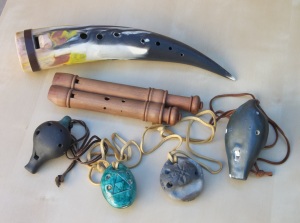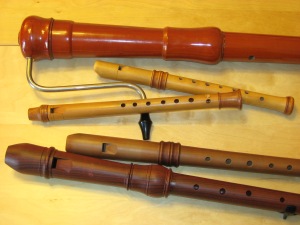The symfonias (hurdy-gurdies) that I play were made by master builder Helmut Seibert of Oberhof, Germany. The one in honey maple (Seibert’s “Unger” design) is pitched in G, and is based on a drawing from the 18th century, but the style is reminiscent of depictions of the simfonia from the 14th and 15th centuries. The instrument in darker mahogany is in C, and is the popular “Pilgerleier” (“pilgrim’s lyre”), reminiscent of the old instrument in the Nuremberg museum. Both have capo sliders that bring the burdon and trumpet string up a whole step to allow a minor mode, and both have Shadow pickups for direct input.
One seven course lute, and one four course mandora. Both are 16th century style instruments.
My pipes and tabors. I have low C, low D, F, G, A, Bb, C, and D pipes, made by Charles Wells, Ralph Sweet, Generation, and Susato. My tabors are made by Ben Harms. I also have a “tambourin a cordes.” Note also the fancy beaters!
My vessel flutes, or “ocarinas,” as well as a gemshorn (also in the vessel flute family). In the center is a double-chambered drone ocarina, with an adjustable plunger to facilitate a whole-step change in the drone pitch (as well as another plunger on the chanter vessel for fine-tuning). This was a custom instrument made by the Wood-n-Bone workshop in New Zealand, fashioned in Rata wood. This superb instrument is great fun to play, and the drone helps to emphasize rhythms.
My reed instruments.
At the top is a capped-reed instrument called a “Kelhorn” from the Susato workshop in North Carolina. Although the length of an alto recorder, the bore is convoluted so as to compact the vibrating length of a bass instrument. This is the same idea as the “rankett” of the 16th century.
Next down is a drone bladder-pipe from Petr Cip’s workshop in the Czech Republic. The chanter has an ambitus of nine notes, the lowest being C, and the drone can be quickly adjusted with that handy leather collar for a pitch of C or D. Since the fingering of the chanter is chromatic, and the drone is unison with the two lowest chanter notes, this instrument has a functional capacity of C major, D minor, D major, G minor, G major, and F major, with lots of modal possibilities.
Resting on the bladder-pipe sack is another capped reed from Petr Cip’s workshop, a rauschpfeife. This has a low note of G, and it plays very well in G, C, Am, Em, Dm, and D major. With practice, part of the second octave is attainable, which is unusual for a capped reed instrument.
Below that are two more capped reeds from the Susato workshop: a soprano cornemuse and an alto crumhorn.
Whistles, or “feadog” in Irish. In the Praetorius Syntagma Musicum, he refers to these as “dolzfloten.”
One low D and one high D, both from Susato. The wood one is in C, by Ralph Sweet.
Recorders, SATB.








Leave a comment